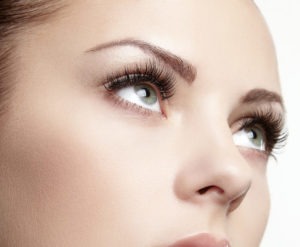 Thyroid Eye Disease (TED), also known as Graves’ orbitopathy, is an autoimmune condition that affects the muscles and tissues around the eyes. This condition is commonly associated with hyperthyroidism and Graves’ disease but can also occur in individuals with normal or low thyroid function. TED can cause discomfort, vision problems, and significant changes in appearance. Fortunately, oculoplastic surgery offers several effective solutions to restore both function and aesthetics. Khan Eyelid and Facial Aesthetics, led by oculoplastic and reconstructive surgeon Dr. Tanya Khan, provides oculoplastic surgery to patients in Plano, Dallas, Austin, Texas, and surrounding locations.
Thyroid Eye Disease (TED), also known as Graves’ orbitopathy, is an autoimmune condition that affects the muscles and tissues around the eyes. This condition is commonly associated with hyperthyroidism and Graves’ disease but can also occur in individuals with normal or low thyroid function. TED can cause discomfort, vision problems, and significant changes in appearance. Fortunately, oculoplastic surgery offers several effective solutions to restore both function and aesthetics. Khan Eyelid and Facial Aesthetics, led by oculoplastic and reconstructive surgeon Dr. Tanya Khan, provides oculoplastic surgery to patients in Plano, Dallas, Austin, Texas, and surrounding locations.
Understanding Thyroid Eye Disease
TED occurs when the immune system mistakenly attacks the soft tissues and muscles around the eyes, leading to inflammation and swelling. Over time, this can result in various complications, including:
- Bulging eyes (proptosis): The eyes appear more prominent due to swelling of the tissues behind the eyeball.
- Eyelid retraction: The upper or lower eyelids pull back, exposing more of the eye’s surface.
- Double vision (diplopia): Swollen muscles can affect eye movement and alignment.
- Dryness and irritation: The inability to fully close the eyelids can cause chronic dry eye symptoms.
- Vision loss: In severe cases, swelling compresses the optic nerve, threatening eyesight.
How Oculoplastic Surgery Can Help
When non-surgical treatments like corticosteroids, eye drops, and lifestyle modifications are not enough, oculoplastic surgery can provide significant relief and restore eye function. Several surgical options are available, depending on the severity of TED symptoms:
1. Orbital Decompression Surgery
- Reduces pressure in the eye socket by removing excess bone or fat from the orbit.
- Helps correct bulging eyes (proptosis) and relieves pressure on the optic nerve.
- Can improve vision and provide a more natural eye appearance.
2. Eyelid Surgery (Eyelid Retraction Repair)
- Adjusts the position of the eyelids to reduce excessive exposure of the eye.
- Helps alleviate dryness, irritation, and cosmetic concerns.
- Improves blinking and eye closure for better lubrication.
3. Strabismus Surgery
- Corrects double vision (diplopia) caused by misaligned eye muscles.
- Helps restore proper eye movement and alignment.
4. Cosmetic Reconstruction
- Addresses aesthetic concerns after TED stabilization.
- May involve lower eyelid repositioning, fat grafting, or other refinements to enhance symmetry.
What to Expect from Surgery
- Treatment Timing: Surgery is typically performed after the active phase of TED has stabilized, usually 6 months to 2 years after onset.
- Recovery: Swelling and bruising are common but subside within a few weeks. Full healing may take a few months.
- Results: Patients often experience both functional improvements (better vision, reduced discomfort) and cosmetic enhancements (more natural eye shape and symmetry).
Is Oculoplastic Surgery Right for You?
If TED is affecting your vision, comfort, or confidence, an oculoplastic surgeon can help determine the best treatment plan. A comprehensive evaluation will assess your eye function, orbital structure, and overall health to recommend the most suitable procedure.
Conclusion
Thyroid Eye Disease can be challenging, but oculoplastic surgery offers a path to relief and restoration. Whether addressing bulging eyes, eyelid retraction, or double vision, these specialized procedures can significantly improve both function and appearance. If you or a loved one are struggling with TED, consulting with an experienced oculoplastic surgeon is the first step toward achieving lasting relief and renewed confidence.
For more information about procedures and treatments at Khan Eyelid and Facial Aesthetics by Ophthalmic surgeon Dr. Tanya Khan. Click here to contact us.
Taking patients from in and around Dallas, Plano, Fort Worth, Grapevine, Garland, Mesquite, Carrollton, Irving, Frisco, Texas and more.


 Oculoplastic surgery is a specialized field that focuses on the eyes and surrounding structures, offering both cosmetic enhancements and functional corrections. Whether for aesthetic improvements or medical necessity, oculoplastic procedures can significantly impact a person’s quality of life. But what exactly is the difference between cosmetic and functional oculoplastic surgery? Let’s explore the key distinctions and how each type of procedure benefits patients. Khan Eyelid and Facial Aesthetics, led by oculoplastic and reconstructive surgeon
Oculoplastic surgery is a specialized field that focuses on the eyes and surrounding structures, offering both cosmetic enhancements and functional corrections. Whether for aesthetic improvements or medical necessity, oculoplastic procedures can significantly impact a person’s quality of life. But what exactly is the difference between cosmetic and functional oculoplastic surgery? Let’s explore the key distinctions and how each type of procedure benefits patients. Khan Eyelid and Facial Aesthetics, led by oculoplastic and reconstructive surgeon






Schedule a Consultation: 972-EYE-LIDS (393-5437)